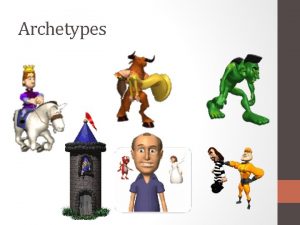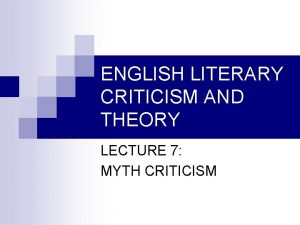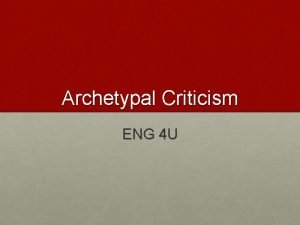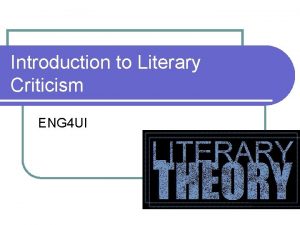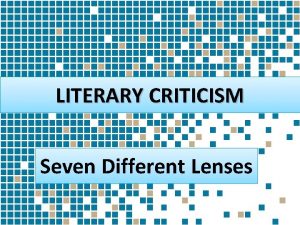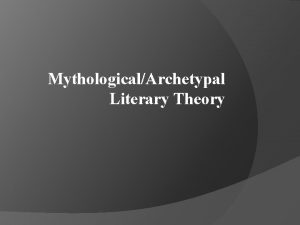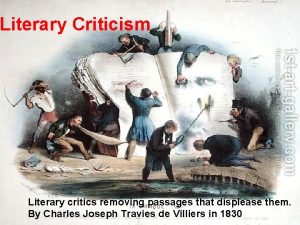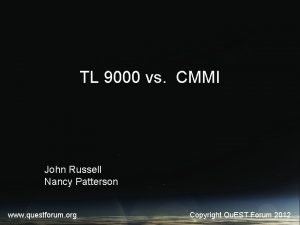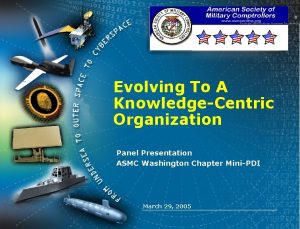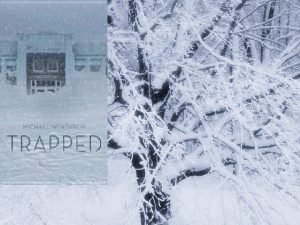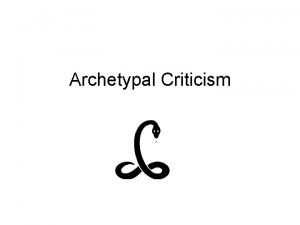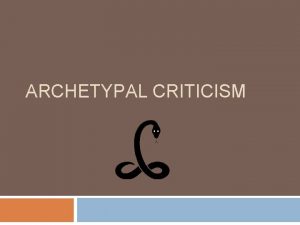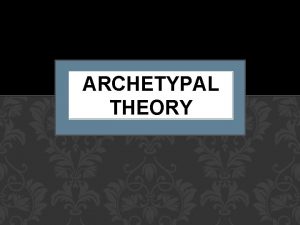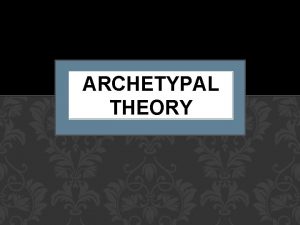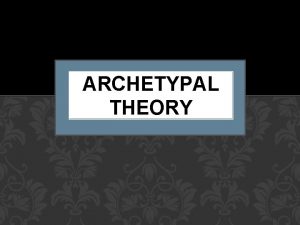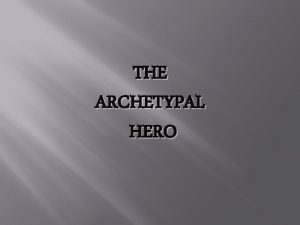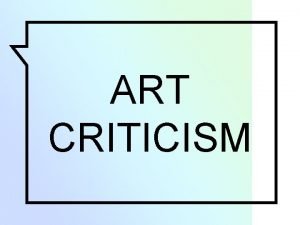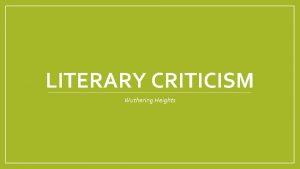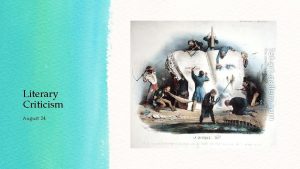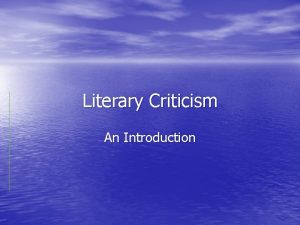Northrop Frye Archetypal Criticism ENG 4 UW Mrs














- Slides: 14

Northrop Frye Archetypal Criticism ENG 4 UW - Mrs. Crowell Frye, Northrop. “The Archetypes of Literature, ” 20 th Century Literary Criticism. ed. D. Lodge, Longman House 1972.

Literary Criticism Review • Literary Criticism is the study and interpretation of a literary work. • Its purpose is to explain literature’s meaning, method, value and goals. • The process of analysis is to examine literature through varied lenses to comment and judge the content’s qualities and techniques while understanding how it comments on the value of society.

Literary Criticism Application Upon Seeing an Orange… Gender Theory Asks… What possibilities are available to a woman who eats this orange? To a man? Formalism Asks… What shape and diameter is the orange? Social Class Theory Asks… Who owns the orange? Who gets to eat it? Biographical Theory Asks… Who grew the orange? What experiences shaped the orange’s growth? Postcolonialism Asks… Who doesn’t own the orange? Who took the orange away? Reader Response Theory Asks… What does the orange taste like? What does the orange remind us of? Structuralism Asks… How are the orange peel and the flesh differentiated into composite parts of the orange? Deconstruction Asks… If the orange peel and the flesh are both part of an “orange, ” are they not in fact one and the same thing?

Who is Northrop Frye? • One of the most recognized authors of literary criticism world-wide, Northrop Frye studied at both the University of Toronto and Oxford, lecturing at U of T until his death in 1991. “Literature imitates the total dream of man. ”

What is an archetype? • According to the Oxford Dictionary: • A very typical example of a certain person or thing. • An original which has been imitated; a prototype. • A recurrent symbol or motif in literature, art or mythology. • In Jungian theory, a primitive mental image inherited from the earliest human ancestors, and supposed to be present in the collective unconscious.

Frye’s Scientific Approach • In “The Anatomy of Criticism” (1957), Frye looks with dismay at literary criticism dependent on personal judgement; instead, he offers a more scientific approach to criticism by looking at “identifiable patterns in myth and archetype. ”

Looking through a Viewfinder • Literary Criticism requires that we look at literature through a variety of lenses. • Frye’s work is similar in that he identifies phases of myth and the archetypes associated with four phases.

1. The dawn, spring and birth phase. • Myths of the birth of the hero, of revival and resurrection, of creation and (because the four phases are a cycle) of the defeat of the powers of darkness, winter and death. • Subordinate characters: the father and the mother. • The archetype of romance and of most dithyrambic and rhapsodic (expressive and passionate) poetry.

2. The zenith, summer, and marriage or triumph phase. • Myths of apotheosis (divinity), of the sacred marriage, and of entering into Paradise. • Subordinate characters: the companion and the bride. • The archetype of comedy, pastoral and idyll.

3. The sunset, autumn and death phase. • Myths of fall, of the dying god, of violent death and sacrifice and of the isolation of the hero. • Subordinate characters: the traitor and the siren. • The archetype of tragedy and elegy.

4. The darkness, winter and dissolution phase. • Myths of the triumph of these powers; myths of floods and the return of chaos and of the defeat of the hero. • Subordinate characters: the ogre and the witch. • The archetype of satire. • The quest of the hero also tends to assimilate the oracular.

The central idea is… • To apply one or more of these phases (lenses) to the stories that we read. • To allow ourselves to interpret and understand stories based on existing archetypes and theories about story.

Your opinion isn’t enough… • You must make connections to the readings in order to establish a relevant voice. • You are expected to use justifications with direct quotations and examples from readings and literary criticisms.

Connecting the Dots… • What makes stories important in your life? • Think of all those stories your parents told you when you were little. Think of all the stories they tell you now. What differences do you notice between their stories then and now? • Think of all the stories with which ad agencies and the movie industry are continually bombarding you. Think of the stories your friends tell you all the time. Think about truth. Are these stories true? Are they lies? If they are ‘creative, ’ does that make them bad or insignificant? • What is a story? How do we distinguish between stories and the things people tell each other that are not stories? Which kind of communication is more important? When does one become the other? Why? • Why is it that we haven’t finished telling all of the stories that need to be told? Or have we? • What have writers and other people said about stories? Do you agree? Disagree? Why?
 The definition of archetype
The definition of archetype Northrop frye archetypes
Northrop frye archetypes Eng katta va eng kichik qiymatlari
Eng katta va eng kichik qiymatlari Loner archetype
Loner archetype The most common critical stances for literature
The most common critical stances for literature Literary lenses examples
Literary lenses examples Mythological theory
Mythological theory Archetypal criticism questions
Archetypal criticism questions John russell northrop grumman
John russell northrop grumman Northrop
Northrop Northrop
Northrop Northrop grumman suppliers
Northrop grumman suppliers Linda northrop
Linda northrop Northrop grumman magna
Northrop grumman magna Harvard university alumni affairs and development
Harvard university alumni affairs and development
